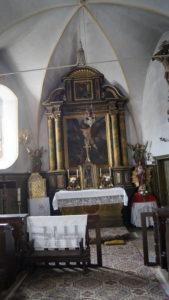On our second to last day of vacation we planned to spend the night in Munich near the airport to alleviate the travel burden. For no other reason than proximity and price, Kimberly reserved us a hotel room at an old historic hotel in Freising which was an 800 m walk from the train station. Since the next day was Sunday, she figured I could go to Mass at the historic church central to the old European town.
Now all this turned out to be providential in the extreme. After dropping off our luggage we ventured around the cobblestone streets looking for a place to eat and to reconnoiter the church that I would visit early the next morning. The moment we got outside, church bells sounded and echoed from all directions. I thought it was simply signaling the hour but the clamor continued for over twenty minutes. I remember thinking, “does this happen every hour?” Seemed like such a frequent usage of the bells would take the charm out of it but maybe the townspeople have zoned it out of their mind and hearing.
Rain started to fall and the streets seem to empty has if a siesta had set in which, at about 2 PM, might have been reasonable were this not Germany. We walked along stumbling up steep cobblestone streets and narrow passages. The grounds of the church seemed empty advertising an “after hours” feeling. I just wanted to get a glimpse and see if Mass times were posted. Drawing closer we could hear some singing and faint music—probably choir practice.
We found what was the large wooden “front door” and Kimberly creaked it open, peaked in, looked around and walked through. I followed.
What I saw was not what I expected (a mostly empty church with plain clothes chorister singing in some corner). Not nearly: the expansive church was packed with people, many standing on the steps and back entry way. At the back was a huge raised area lined with clergy and at the head sat three seated men with vestments and large miters. Was this a Mass in the middle of the day? What is going on in here?
What we discovered was a celebration of the Feast Day of Saint Korbinian, patron of the city and the Freising-Munich diocese overall. This was not some old magnificent Church and monastery, but the very Cathedral and chair of the bishop—the same bishopric once shepherded by Joseph Ratzinger (Pope Benedict XVI). My undaunted wife marched up to the gallery where we sat overlooking the expanse of the Cathedral right next to the organ / orchestra loft. The whole ritual was saturated in the most glorious and sacred of music. Before the altar at the bottom of the steps was what appeared to be the reliquary of Saint Korbinian himself which underwent an incensing and a walk around the sanctuary with a huge procession of bishops, priests and altar kids. As the bishop walked behind it, he laid hands on all the children for blessing. Others handed out medals, presumably of the saint, to any kid who wanted one—and who did not want one? Heck, I wanted one.
We were there for at least an hour and the “service” ended with the Salve Regina sung in the same tune we sing at St. Catherine. Of course I joined in—it was astounding.


